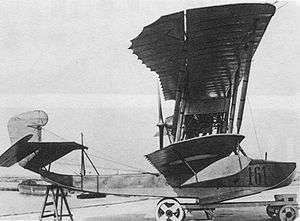Grigorovich M-9
| M-9 | |
|---|---|
 | |
| Grigorovich M-9 | |
| Role | Reconnaissance flying boat |
| Manufacturer | Shchetinin |
| Designer | Dmitry Pavlovich Grigorovich |
| First flight | January 9, 1916 |
| Retired | 1920s |
| Primary users | Russian navy Finnish Air Force |
| Number built | ca 500 |
| Developed from | Grigorovich M-5 |
Grigorovich M-9 (alternative designation ShCh M-9, sometimes also Shchetinin M-9) was a Russian World War I-era biplane flying boat, developed from the M-5 by Grigorovich.
The first M-9 was ready in 1915 and its maiden flight was carried out on January 9, 1916 at Baku. On September 17, 1916, the test pilot Jan Nagórski became the first to make a loop with a flying boat.
During the Russian Civil War, M-9s participated in the air defence of Baku, dropping approximately 6,000 kg of bombs and 160 kg of arrows. The aircraft also carried out photo reconnaissance, artillery spotting and air combat sorties.
The M-9 was also used for the first experiments on sea shelve study, participating in the finding of new oil fields near Baku.
Nine M-9s were captured by Finland during the Russian Civil War. One was flown by a Russian officer to Antrea on April 10, 1918. It sank the following day during type evaluation. Eight more were taken over at the airfields at Åland and Turku. The aircraft were used until 1922 by the Finnish Air Force.
Operators
Specifications (M-9)
Data from Thulinista Hornettiin
General characteristics
- Crew: 2
- Capacity: 1
- Length: 9.00 m (29 ft 6 in)
- Wingspan: 16.00 m (52 ft 6 in)
- Height: m (ft in)
- Wing area: 54.8 m² (589.6 ft²)
- Empty weight: 1060kg (lb)
- Useful load: kg (kg)
- Loaded weight: 1540kg (lb)
- Max. takeoff weight: 1,610 kg (3,542 lb)
- Powerplant: 1 × Salmson 9 pusher radial engine, 111 kW (150 hp)
Performance
- Never exceed speed: km/h (knots, mph)
- Maximum speed: 110 km/h (59 knots, 68 mph)
- Cruise speed: km/h (knots, mph)
- Stall speed: km/h (knots, mph)
- Range: km (nm, mi)
- Service ceiling: 3,000 m (9,840 ft)
- Rate of climb: m/s (ft/min)
- Wing loading: kg/m² (lb/ft²)
- Power/mass: W/kg (hp/lb)
- Endurance: 3.5 hours
Armament
- 1x 7.7 mm MG or
1x 7.5 mm MG or
1x 20 mm cannon or
1x 37 mm cannon
See also
| Wikimedia Commons has media related to Grigorovich M-9. |
- Related lists
References
Bibliography
Heinonen, Timo: Thulinista Hornetiin - Keski-Suomen ilmailumuseon julkaisuja 3, Keski-Suomen ilmailumuseo, 1992, ISBN 951-95688-2-4